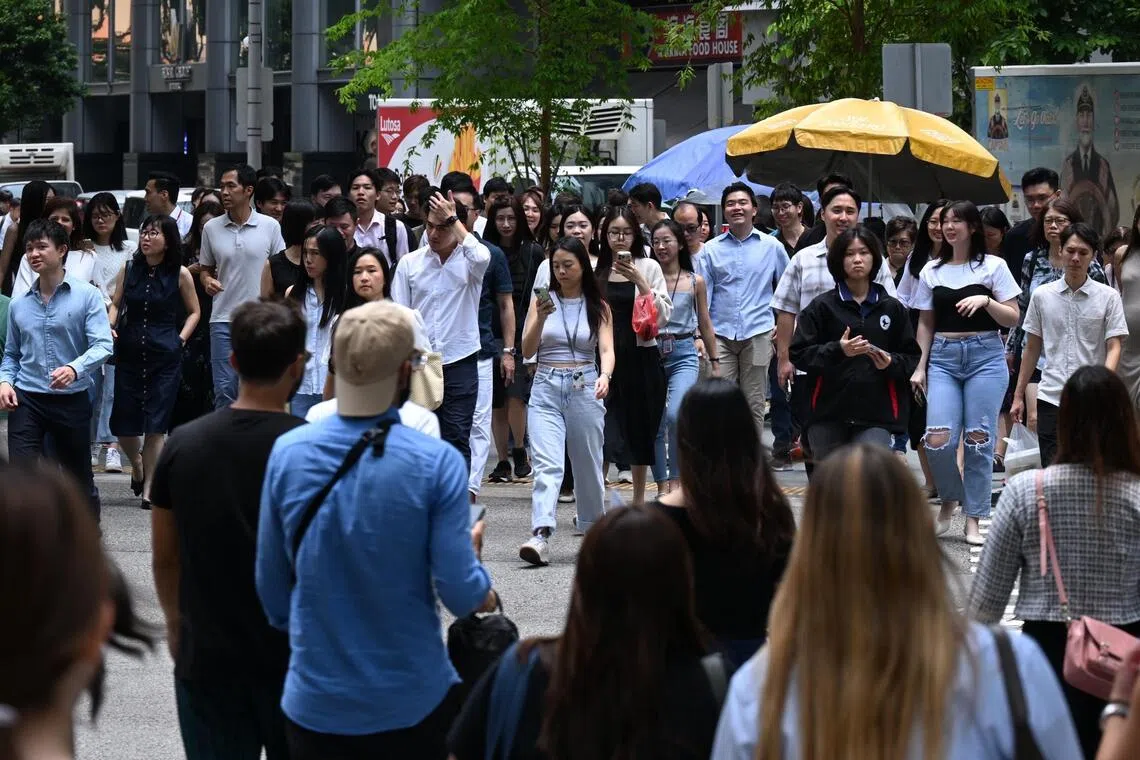News analysis
Singapore Opportunity Index must not benefit only larger firms: Industry insiders
Sign up now: Get ST's newsletters delivered to your inbox

The new index measures how much an employer provides salary and career growth.
ST PHOTO: CHONG JUN LIANG
Follow topic:
- The Singapore Opportunity Index measures career growth provided by employers with 100+ Singaporean/PR employees.
- Industry experts highlight concerns that the index may disadvantage smaller, progressive firms excluded from the initial ranking.
- Stakeholders suggested an adapted version for smaller companies, focusing on applying best practices to improve talent development.
AI generated
SINGAPORE – A new Singapore Opportunity Index unveiled earlier in October
However, even as they broadly lauded the move, industry players The Straits Times spoke to said care must be taken to ensure the index does not compound hiring challenges for smaller employers.
To ensure the results are statistically meaningful, the first iteration of the index includes only public- and private-sector employers with 100 or more Singaporean and permanent resident employees.
These employers are scored based on various metrics relating to retention, progression, pay, gender parity and hiring practices, with the top 300 set to be named on an unranked list come the first quarter of 2026.
This has given rise to concerns that smaller firms that can provide strong growth will face an uphill battle to catch the attention of job seekers compared with larger firms with sterling performance on the index and named on the list.
“The current threshold of 100 Singapore resident employees may unintentionally exclude many smaller yet progressive employers,” said Mr Julian Tan, founder and chief executive of jobs platform operator FastCo.
“These firms often innovate in flexible work arrangements, skills-based hiring, and upskilling opportunities.”
These include smaller local offices of multinationals that can tap the resources of their motherships, as well as firms with outsized earnings potential in cutting-edge sectors such as digital payments, noted Ms Teo Wei Yun, director for risk and governance hiring at Ethos BeathChapman, an executive search firm.
“Such employers tend to offer more flexibility across scope, with the chance to take on more roles within the firm as employees progress in their careers,” she said.
“There is also the potential for strong wage growth due to their lean grading systems coupled with a broader scope of responsibilities in Singapore.”
She added that in her firm’s experience, entry- to mid-level candidates tend to give weight to employer rankings when deciding where to start or grow their careers.
The index has also set both human resources professionals and candidates in Ethos BeathChapman’s network abuzz, with many of them viewing the move as a way to allow both job seekers and employers to make more informed decisions, she said.
Is a different yardstick needed?
Even if smaller firms could be scored on the index, there are some innovative workforce practices that could detract from some measures on the index, said Mr Lee Tuck Wai, who chairs the human capital action group at the Association of Small and Medium Enterprises.
For instance, he said he knows of several small and medium-sized enterprises (SMEs) that have adopted a more agile hiring approach given the economic flux, with more workers hired on short-term contracts or on various part-time, gig-based arrangements.
“We are asking them to think beyond traditional hiring, but some of these things don’t play well with (metrics) like retention.
“While we are trying to adapt to the new economy, these are very traditional statistics.”
The index has been designed to adjust for the mix of job types in a company, as well as to ensure companies are compared against industry peers.
Still, it remains unclear how varying sector-specific norms in wage progression and career pathways are taken into account.
“Employers will need to trust that the methodology fairly reflects their realities – particularly for industries where wage progression or career paths are structured differently,” said Mr Tan of FastCo.
Associate Professor Kang Soon Hock also flagged the potential for users of the index – both firms and job seekers – to narrowly fixate on one dimension, rather than overall performance.
“If this occurs, then the utility of this index to help firms would be greatly hampered,” said Prof Kang, who is one of the Singapore University of Social Sciences researchers who helped develop the index alongside American independent think-tank The Burning Glass Institute and the Ministry of Manpower (MOM).
Prof Kang said the five dimensions – retention, progression, pay, gender parity and hiring practices – are closely tied to the opportunities that an employer can provide, all of which are crucial to an employee’s career.
On the broader significance of the index, he said: “Most importantly, it presents a complete picture of the landscape because, in this particular exercise, eligible firms cannot choose not to participate.”
The first iteration of the index covers nearly 1,500 employers, which collectively employ nearly a million Singapore citizens and permanent residents.
Adapting measures and sharing practices
Industry players ST spoke to called for an adapted version of the index for smaller companies after this first iteration gains traction.
“The index could help encourage fairer and more transparent employer branding, but smaller firms like ours would also benefit from complementary visibility channels that spotlight progressive SMEs,” said Mr Tan of FastCo, which has around 30 employees in Singapore and is hiring for openings in marketing and business intelligence.
MOM has previously said it is exploring how to ensure smaller companies benefit from the index, such as by working with them on applying the index more selectively, and sharing applicable best practices from top firms.
Policymakers have also expressed hope that the precise data and comparisons with industry peers from the index would galvanise employers to invest more heavily and meaningfully in developing talent, thereby matching up to both government workforce policies and workers’ own upskilling efforts.
But while data is an important enabler, it is not a complete solution, said Mr Gabriel Lim, executive director of the Singapore Furniture Industries Council, an industry body for a sector with numerous SMEs here.
“The key is to turn insights into practical steps that smaller firms can act on.”
For instance, many furniture SMEs attract promising young talent but lose them early owing to unclear career pathways or limited exposure to innovation, Mr Lim said.
“These issues persist because many SMEs lack the resources to build structured human resources systems for training and progression.”
This is where industry bodies like the council have to come in – to help companies translate the information into practical action, such as by connecting firms to the necessary support, he said.
In the Singapore National Employers Federation’s (SNEF) view, the metrics covered by the index offer a constructive starting point, said Mr Benjamin Boh, SNEF council member and co-chair of the Tripartite Workgroup on Human Capital Capability Development that mooted the index earlier in 2025.
“While no single index can capture every aspect of what makes a good employer, the Singapore Opportunity Index’s approach encourages meaningful benchmarking and supports a common understanding of good human capital standards across all sectors.”
However, he added that different sectors operate under unique conditions and workforce structures, so the index should be interpreted as a guide, instead of a rigid standard.
He encouraged employers to adapt best practices to suit their own industry practicalities and workforce profiles.
“Finally, it is important to note that not being among the top 300 does not mean that a company is not a good employer,” Mr Boh added. “Many companies continue to make significant contributions through meaningful employment, capability-building and inclusive practices.”


